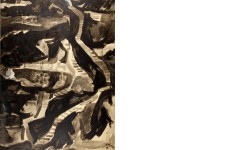Υδατογραφία 17Μικτή Τεχνική 5Ελαιογραφία 72Χαρακτική 1Σχέδιο 7Τέμπερα 6Παστέλ 3Ακρυλικά 1Gouache 1Λαδοπαστέλ 2
Ειδικές Πληροφορίες για τον Καλλιτέχνη
TITΛΟΣ ΕΡΓΟΥΤΟ ΝΗΣΙ ΤΗΣ ΣΙΦΝΟΥ
ΔΙΑΣΤΑΣΕΙΣ ΕΡΓΟΥΎψος : 203
Πλάτος : 157
ΥΛΙΚΟ ΚΑΤΑΣΚΕΥΗΣΣχέδιο (Μελάνι σε χαρτί)
ΥΠΟΓΡΑΦΗ ΚΑΛΛΙΤΕΧΝΗΚάτω Δεξιά
ΧΡΟΝΟΛΟΓΗΣΗ01-01-1969
ΕΛΕΓΧΟΣ ΓΝΗΣΙΟΤΗΤΑΣΔεν έχει ελεγχθεί

Footnotes
The work is registered in the e-archive DAMSpace of ISET (Institute of Contemporary Greek Art) under the number AR0537_PHWR_00383
Exhibited
Athens, Nees Morfes Gallery, P. Tetsis, The Black-and-Whites 1968-1970, May 12 June 10, 1992 (possibly).
Athens, Ersi Gallery, 1999.
Naples, Palazzo Reale, Sala Dorica, The Olympic Games, March 30 - May 5, 2003.
Athens, Goulandris Museum of Cycladic Art, The Olympic Games, 2003.
Venice, Chiesa di San Giovanni Enangelista, The Olympic Games, October 1 - November 511 2003.
Athens, Glikas Gallery, Capitalising on the 1930s Generation, The Great Studios and the Successors, November 29, 2010 January 29, 2011 (illustrated in the exhibition catalogue, p. 9).
Literature
Rifts and Convergences, Greek Art of the 60s and the 70s from the Leonidas Beltsios Collection, Trikala 2000.
A work of commanding presence and sweeping grandeur, this extraordinary view of the island of Sifnos recalls the famous verse from O. Elytis's 'Axion Esti', "the porous and white noon". Tetsis, the painter who muses over colour and dwells in its depths and whom the art critics often refer to as a 'hedonist of colour rituals', has produced works whose main characteristic is the wonderful texture achieved by juxtaposing black and white. In these monochromatic canvases, white is not a mere backdrop but an active colour, charging the entire composition with an exhilarating vibe.
His views of Sifnos, which the artist regularly visits since 1968, comprise a significant part of his entire output. In these pictures, the outlines are never static but, instead, make up an intricate web that invites the viewer's eye to follow the island's stone pathways to the upper limits of the canvas and observe the landscape from a top-down, birds-eye view. This web that spreads across the canvas ruling out the horizon or any other indication of depth, conveys a sense of a continuous pictorial plane that unfolds like a scroll, where the light seems to emanate from within the materiality of paint.1
As noted by Professor A. Kotidis, the marked contrast between black and white generated by the sharp light of the Cycladic atmosphere gives these works with the 'angelic and black light'2 an overwhelmingly expressionistic tone -one of the most dramatic in Tetsis's oeuvre.3 The insular landscape with its dry-masonry walls and terraced fields awakens old and vivid memories to the Hydra-born Tetsis. In his hands, the greens and deep browns of the earth turn into blacks to better capture the intensity of the midday light. In a complete reversal, the revealing black ink replaces the blinding Greek light.4
1. See J. Dimakopoulou, "Black-White" and E. Andreadi, "P. Tetsis:The World Around" in Panayotis Tetsis, Today's Painting [in Greek], exhibition catalogue, Megaron Athens Concert Hall, Athens 2011, pp. 13,16.
2. G. Seferis, Kichli, 1947.
3. A. Kotidis, "P. Tetsis: His Work and its Reception" in P. Tetsis, Painting, Nees Morfes gallery, Athens 1999, p. 35.
4. E. Plessa, Ink [in Greek], exhibition catalogue, Medousa gallery, Athens 2012.